Tamron Af 200-400mm F56 Ld 75dn for Nikon Review
According provided past Tamron AF LD 200-400mm 1: five.6 75DN lens (for Nikon cameras) huge cheers to the store www.fotika.com.uawhere you lot can observe a huge number of different used photographic equipment, including similar lenses.
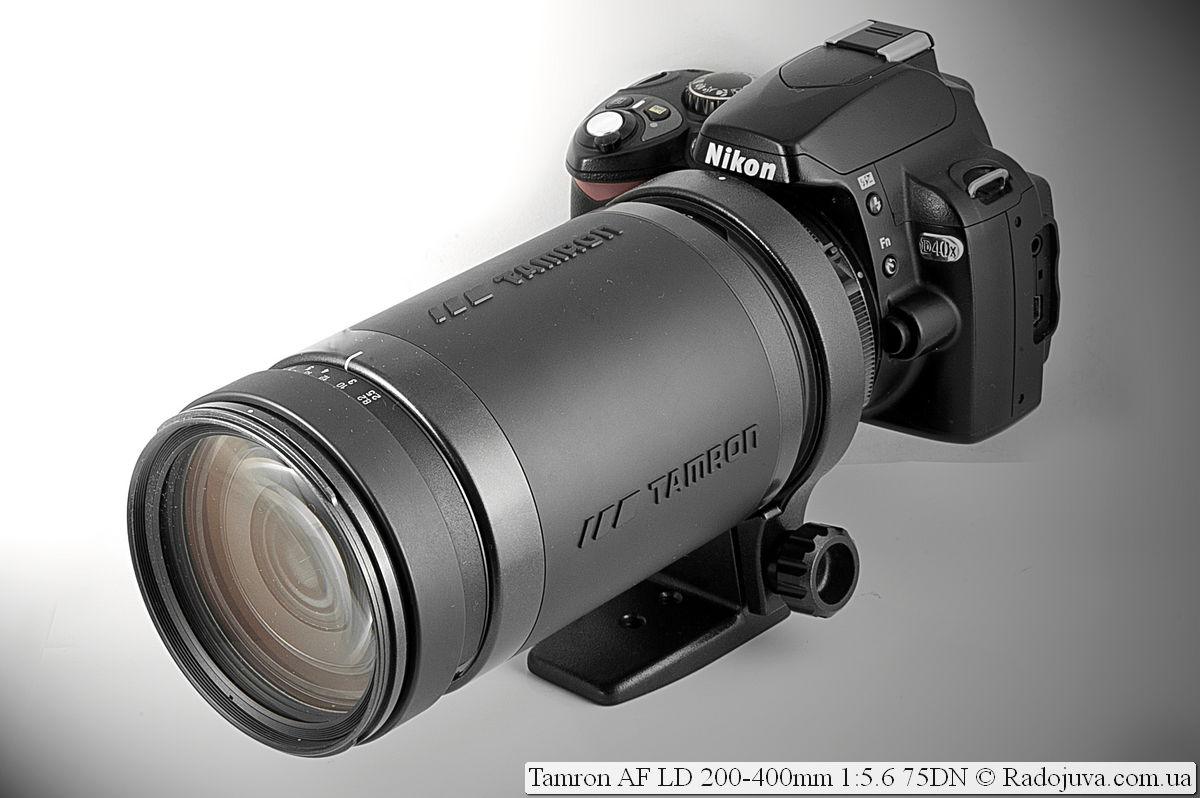
Tamron AF 200-400 F / 5.6 LD on the Nikon D40x
Navigation:
- Briefly most the lens
- Primary Specifications
- Assembly
- Focus Features
- Discontinuity Features
- Paradigm quality
- Sample Photos
- My personal experience with the lens
- Results
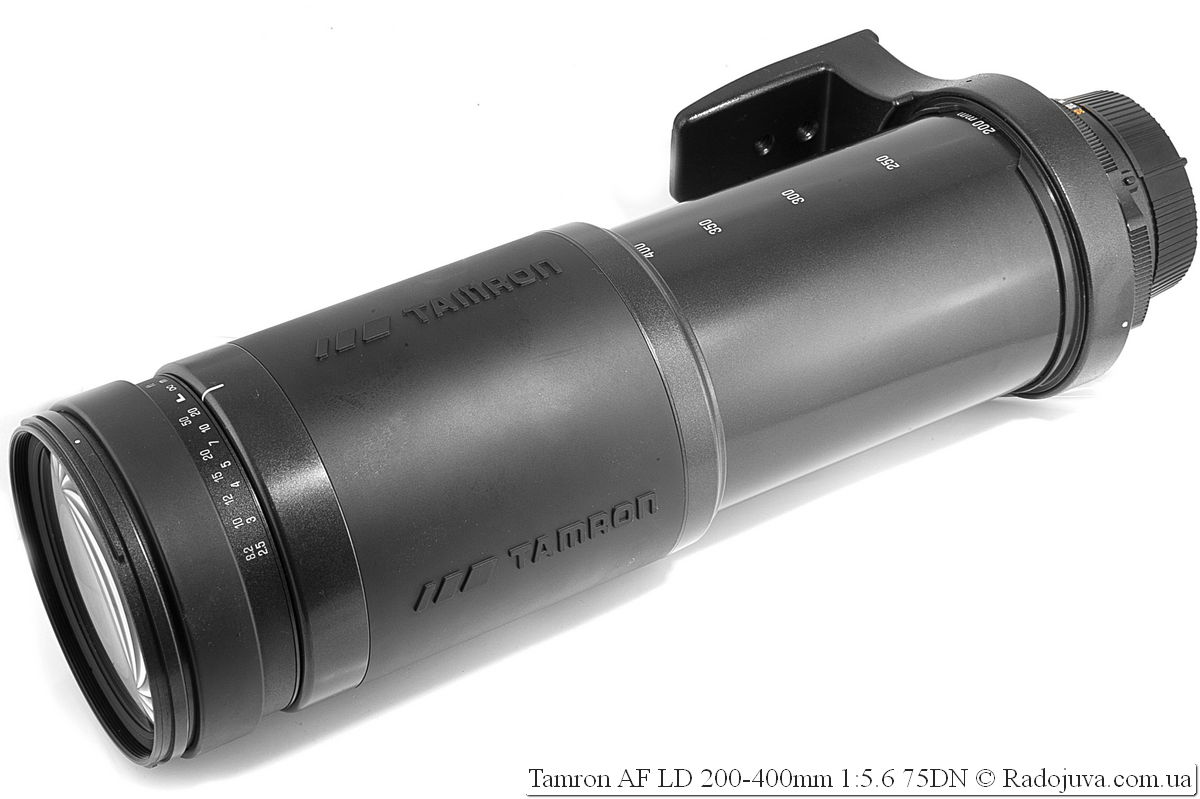
Tamron AF 200-400 F / 5.6 LD
Briefly well-nigh the lens
The Tamron AF LD 200-400mm i: v.half-dozen 75DN is a super telephoto zoom lens with auto focus, this review presents the 75D version for Nikon cameras. The letter 'N' in the model proper noun refers to the version of the lens for Nikon cameras. The lens was also produced in a version for Catechism (version 75DE) and Sony / Minolta (version 75DS) cameras, for Pentax just the side by side model 175D was produced.
Information technology is by and large accustomed that the super-telephoto range for full-size cameras starts later 300 mm, and, in full general, most users have enough of the capabilities of conventional telezoom types 70-300 mm... At the same time, anything longer than 300 mm can provide the lensman with unimaginable possibilities for shooting distant objects. Super telephoto lenses' unusual 'narrow' perspective command can sometimes create an unusual image in whatsoever elementary scene.
Please notation that there are two very similar models - Tamron AF LD 200-400mm 1: 5.half dozen 75D and Tamron AF LD 200-400mm 1: v.six 175D. You tin chop-chop place the versions past the tripod human foot lock, in the 175D version the foot is removable.
In short, the Tamron AF LD 200-400mm 1: 5.6 75DN is one of the cheapest autofocus lenses, which has the ability to use a 400 mm focal length and at the aforementioned time has a relatively poor aperture of 1: 5.half-dozen. In terms of image quality, the lens is no surprise.
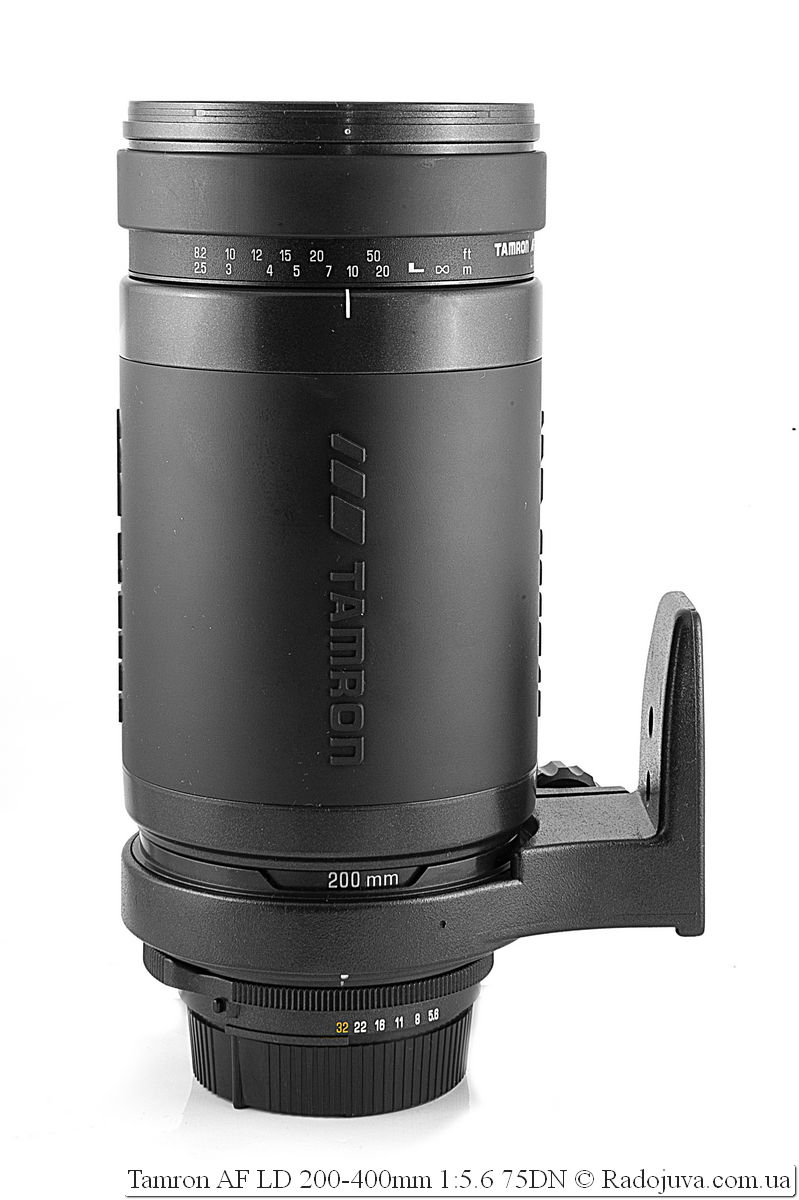
Tamron AF 200-400 F / 5.half dozen LD
Primal Features Tamron AF LD 200-400mm one: 5.half-dozen 75DN
| Review Instance Name | Tamron AF LD 200-400mm 1: 5.6 75DN 502473 |
| Bones properties |
|
| Front Filter Diameter | 77 mm, thread under the filter metal |
| Focal length | 200-400 mm, EGF for Nikon DX cameras is 300-600 mm |
| Zoom ratio | 2X |
| Designed by | for total-format movie cameras |
| Number of discontinuity blades | 9 rounded petals that course a fairly even hole |
| Tags | focusing distance in meters and feet, focal length values for 200, 250, 300, 350, 400 mm, hood mount label and bayonet mount. Marks for the orientation of the tripod foot. Values on the aperture band: v.6, 8, 11, sixteen, 22, 32. |
| Diaphragm | from F / 5.half-dozen over the unabridged range of focal lengths to F / 32. The lens has an aperture ring (Non-Thou - lens type for Nikon cameras) |
| MDF | ii.5 chiliad, maximum magnification ratio one: 6.1 |
| The weight | 1210 g |
| Optical design | xiii elements in 11 groups. The optical design uses Tamron LD low dispersion elements. Figure optical circuit volition non find. The optical pattern is the same equally that of Tamron AF LD 200-400mm i: 5.6 175D |
| Lens hood | Tamron C3FH Japan |
| Manufacturer land | JAPAN (Japan) |
| Period | From 1994 to 2000, subsequently replaced by Tamron AF LD 200-400mm i: v.6 175D (2000-2003) |
Now the 75D and 175D models are replaced by a modern Tamron 200-500mm F / v.0-six.iii Di LD (IF) and supplemented Tamron 150-600mm f / 5-6.3 . The closest original relative can be considered Nikon ED AF VR-Nikkor 80-400mm 1: iv.5-5.6D Vibration Reduction.
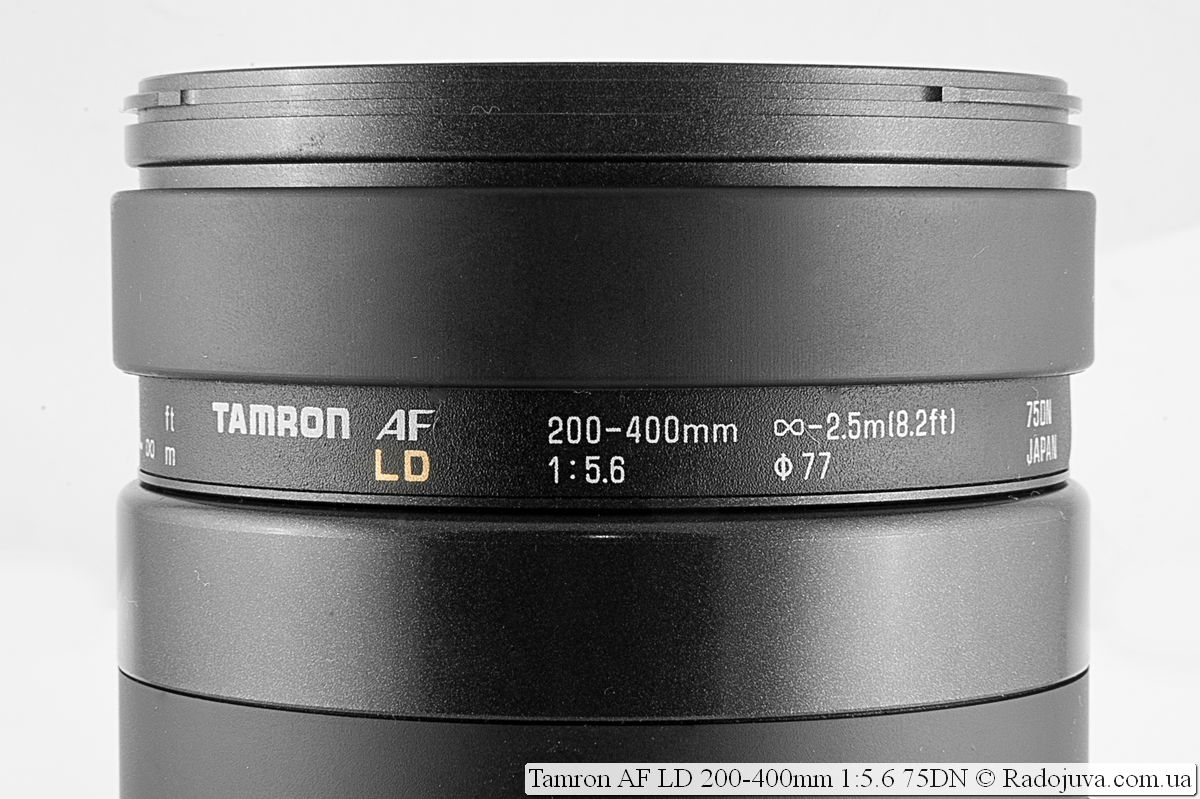
Tamron AF 200-400 F / five.6 LD
Associates
Tamron AF LD 200-400mm i: 5.half-dozen 75DN is very well assembled. Despite the fact that the frame rim lengthens very much during a change in focal length, the monolithic structure remains at a very loftier level. I was very pleased with the quality of functioning of this lens.
The lens uses 77 mm standard professional person diameter filters. Tamron AF LD 200-400mm 1: five.half-dozen 75DN itself is quite large and heavy, just at the same time, if you compare, it turns out that Tamron AF LD 200-400mm i: five.vi 75DN weighs less than, for case, Nikon ED AF Nikkor 80-200mm 1: two.8D MKIII. While working with the lens, I took off my easily and did not find any problems with weight or weight remainder when using it with a photographic camera Nikon D700.
Note that the Tamron AF LD 200-400mm ane: five.half-dozen 75DN is a Push button-Pull lens - a and so-called 'piston' must be used to change the focal length. But this is a two-ring Push button-Pull, which has an additional focusing ring. For example, at that place are single-ring Push button-Pull lenses, where the piston simultaneously serves to focus and change the focal length, for example, such lenses include Nikon ED AF Nikkor eighty-200mm i: 2.8D (MKII).
Unfortunately Tamron AF LD 200-400mm 1: five.6 75DN suffers spontaneous extension of the trunk under its ain weight. As well, I actually do not like very strong knocking in Push-Pull lenses during a sharp modify in focal length, when the piston abuts against the farthermost positions of focal lengths. Sometimes it seems that moving the piston all the way can damage the lens.
The focusing ring and piston are rubberized. In fact, most of the outer barrel of the lens is a rubberized piston that makes it very convenient to hold / back up the lens.
When irresolute the focal length, the rear lens moves in the centre of the lens body like a pump - information technology draws in and pushes out air. This behavior of the rear lens is called 'vacuum cleaner issue', which can increase the amount of dust that accumulates in the photographic camera. The vacuum cleaner effect of Tamron AF LD 200-400mm ane: 5.6 75DN is very, very strong.
Tamron AF LD 200-400mm 1: v.half-dozen 75DN uses a special tripod foot. The tripod foot is stock-still to the lens using a special clamping spiral. Unfortunately, the tripod pes cannot be disconnected. On the case you can find marks for quick installation of the lens in the exact horizontal (mural) or vertical (portrait) position. The tripod pes is metal and very potent.
There is a mark on the case for quick installation of the hood. The lens uses a C3FH plastic lens hood, which is fixed in special grooves located virtually the front lens of the lens. The hood tin be installed in the reverse management for transportation. In this position, access to the focus ring and the zoom piston is lost, and you accept to change the focus while holding on to the hood itself. Hood, although plastic, but very strong. With a lens hood mounted at 400 mm focal length, the lens becomes monstrously long.
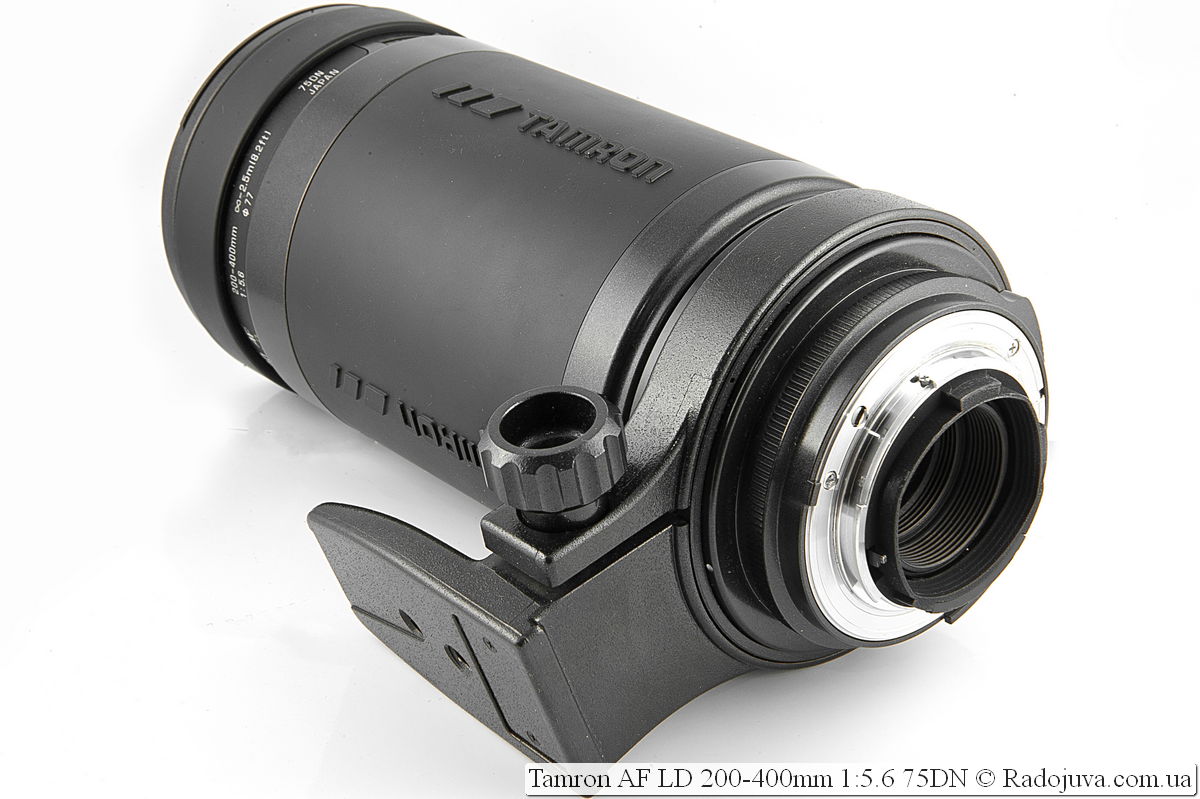
Tamron AF 200-400 F / 5.half-dozen LD
Focusing
Tamron AF LD 200-400mm 1: 5.half dozen 75DN focuses extremely slowly automatically. I was non comfortable working with the lens in any more or less reporting situations. Also, I want to note that on the photographic camera Nikon D700, on which I tested this lens, it very often misses during automatic focusing. Most likely this behavior is due to the fact that the focus sensor MultiCAM 3500FX on the camera Nikon D700 (And other sensors on many Nikon cameras) it is designed to piece of work with a maximum relative aperture of at least ane: 5.6. In this case, F / 5.half dozen is the maximum permissible value. Basically, during focusing misses, the lens / photographic camera tries to focus behind the subject. Also, lighting affects the focus tenacity very much. In cloudy atmospheric condition, the number of rejects due to poor focus was much greater than in clear sunny weather. Slow focusing and focus errors greatly spoiled the overall impression of this lens.
From the positive sides it is worth highlighting presence of focusing of internal type. The minimum focusing distance is ii.v meters (over the entire range of focal lengths), while y'all can shoot Macro with a maximum magnification of 1: vi.1but only at 400 mm focal length. A scale with a focusing distance in meters and feet is plotted on the focus band. Unfortunately, the lens does not take any additional tags, such as the depth of field scale, or tags for working in the infrared spectrum.
I was pleasantly surprised that Tamron AF LD 200-400mm 1: five.six 75DN is practically perfect parfocal the lens. During a change in focal length, he does not driblet a drib of focus on sharpness.
The focus ring rotates approximately 60 degrees, although the lens is chubby, information technology is inconvenient to manually focus on sharpness. During auto focus, the rotating focus ring cannot exist touched.
In that location is no focus mode switch on the lens, the transition to manual focus and vice versa is carried out using the switch on the photographic camera, which is located near the camera mount. There is no focusing altitude limiter, which is sometimes very of import when working with telephoto lenses.
Information technology'southward important: auto focus with this lens is available only when using him on cameras with built-in motor focusing.
Exact list Nikon DSLR cameras with a built-in focus motor, on which this lens volition focus automatically:
- D1, D1h, D1x, D2x, D2xs, D2h, D2hs
- D3, D3x, D3s, D4, D4s, D5, D6
- Df
- D50, D70, D70s, D80, D90
- D7000, D7100, D7200, D7500
- D100, D200, D300, D300s, D500
- D600, D610, D750, D780
- D700, D800, D800E, D810, D810a, D850
- Fujifilm FinePix S1 Pro, S2 Pro, S3 Pro, S3 Pro UVIR, S5 Pro, IS Pro
- Kodak DCS PRO 14n, DCS Pro SLR / north
Verbal list Nikon DSLR cameras without a congenital-in focus motor, on which this lens volition not focus automatically:
- D40, D40x, D60
- D3000, D3100, D3200, D3300, D3400, D3500
- D5000, D5100, D5200, D5300, D5500, D5600
- Nikon z5, Z6, Z6 Two, Z7, Z7 Ii , Z9, Z50... with adapter Nikon FTZ/ FTZ II
Only auto focus and sound confirmation of focus will not work with these cameras, all other important functions, such as automatic exposure metering and automatic iris control, will piece of work well.
You will notice a lot of useful information on the types of cameras and lenses Nikon hither.
During auto focus, the lens and camera pretty noisy.
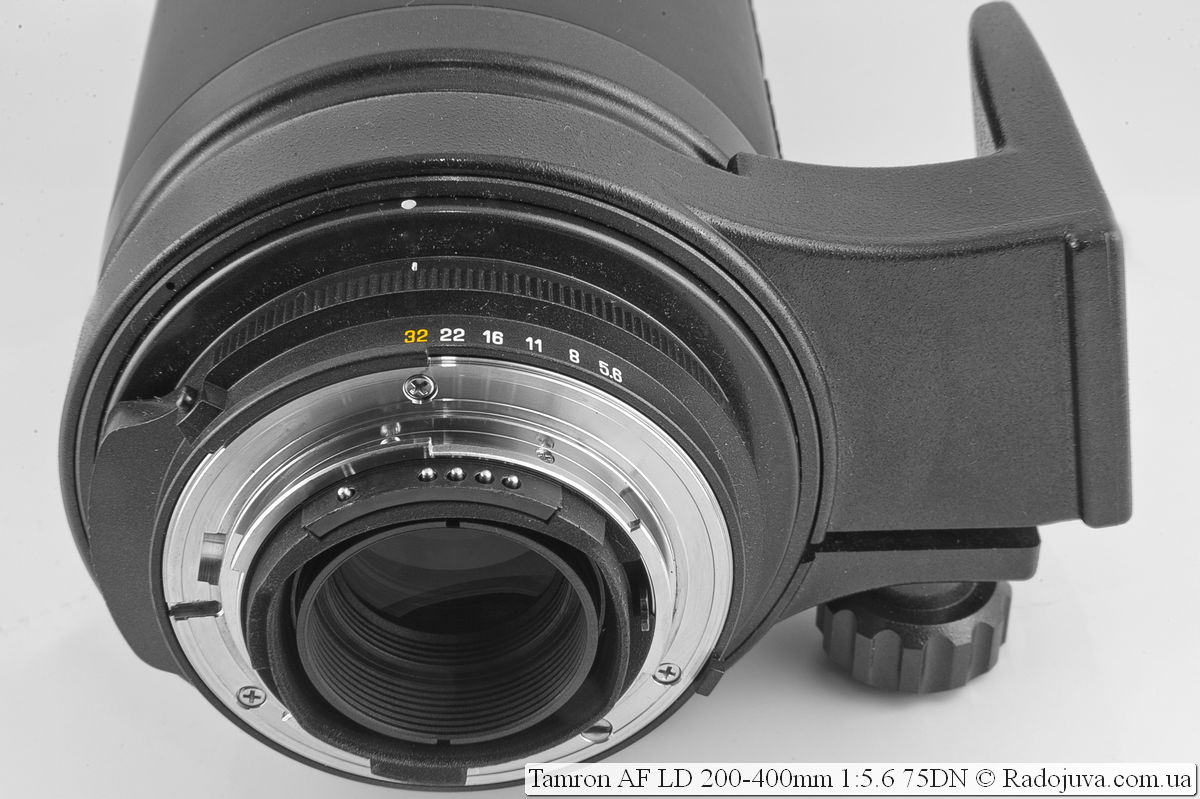
Tamron AF 200-400 F / 5.6 LD
Diaphragm
Diaphragm lens consists of 9 rounded petalsthat form a flat hole. This lens has constant maximum aperture of f / v.6 over the unabridged range of focal lengths. Theoretically, with this lens, you tin can apply teleconverter with a limit of 1.4x, which will plow it into 280-560 / 8, while a number of cameras with a focus sensor supporting work with F / 8 will exist able to focus automatically.
If you install Tamron AF 200-400 F / 5.6 LD with this tele-converter on cropped cameras, such every bit Nikon D7100, D7200 and plough on the 1.3X framing mode, it will exist possible to get a 1092 mm EGF!
The lens has a manual discontinuity ring. To be able to command the value aperture from camera or for automatic installation discontinuity on modern fundamental control valves, y'all need to turn the control ring to the F / 32 value, later on which it is automatically stock-still by a special black push, which is located to the left of the marks aperture. If this is not done, then on a number of cameras, the display will brandish an error - 'fEE' (ring is non installed aperture) Some cameras having diaphragm rheostatallow yous to control the discontinuity using the ring aperturebut only in metering modes exposure 'M' and 'A'. You can read more most this issue in the section on Non-Grand Lenses. Ring aperture rotates with clicks, the values F / 5.6, 8, eleven, 16, 22, 32 are plotted on information technology; information technology is not possible to set an intermediate value between pairs of numbers using the aperture ring. Intermediate values tin just be fix using the camera card. Aperture band has special ledge under the thumb of the left hand for easy control. Such a protrusion is made in order to attain the aperture command band, which is sandwiched betwixt the tripod foot ring and the camera mount.
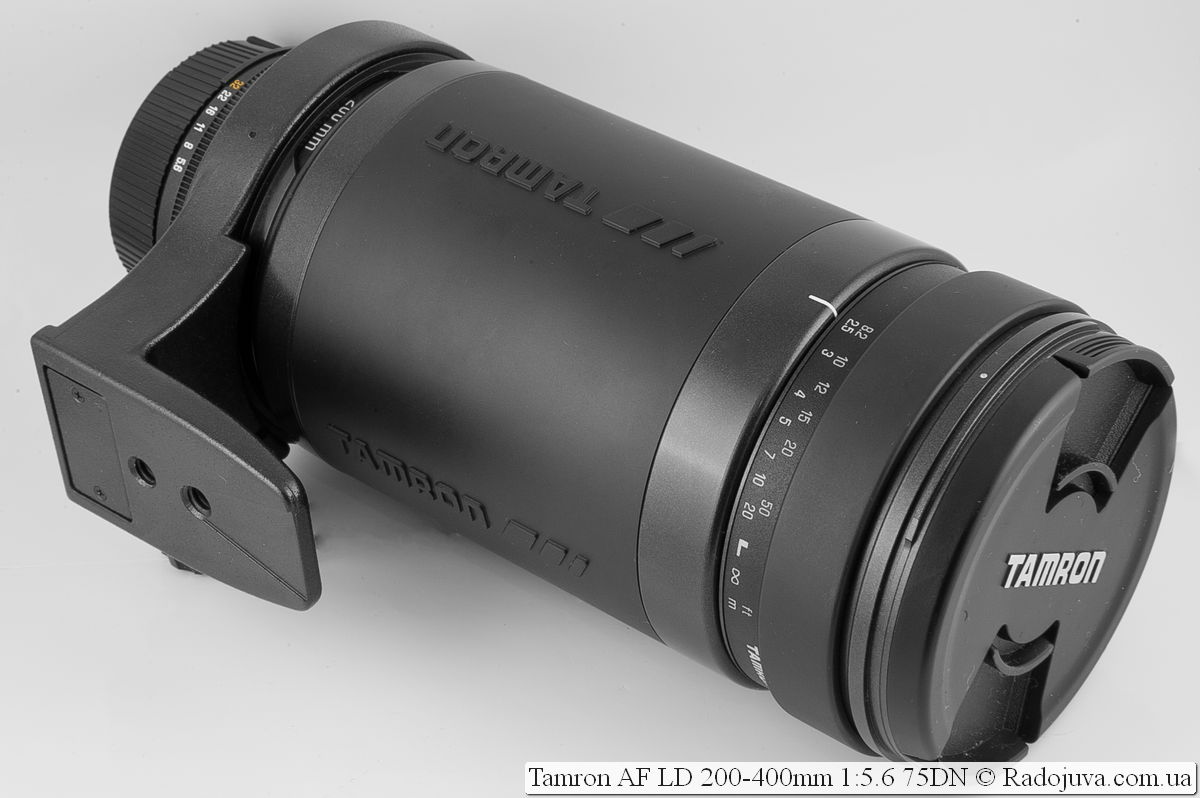
Tamron AF 200-400 F / 5.6 LD
Epitome quality
Unfortunately, I accept to admit that the lens is very weak when working on open up apertures in the range of 300-400 mm. At 200 mm and F / 5.half dozen in the heart of the frame, you can however get an acceptable image quality, only with increasing focal length, sharpness decreases. If you embrace the diaphragm to F / 8-F / 11, then a satisfactory result tin be obtained past 400 mm. I desire to notation that the network has a lot of flattering reviews about the sharpness of this lens already at F / 5.vi. But for the near part they relate to the 175D model, likewise, this may indicate a spread in the quality of the specimens.
Tamron AF 200-400 F / 5.6 LD suffers from excessive chromatic aberration. There is also slight vignetting on open diaphragms. Only distortion in the eye is very hard to notice.
While working with the lens, it became apparent that the Tamron AF 200-400 F / five.6 LD does non like to shoot in stiff side or back light. In backlight, the lens gives an unpleasant yellow orange veil throughout the frame. The hood helps very well to avoid unwanted flare.
In general, the copy that I had on the review showed operation beneath boilerplate.
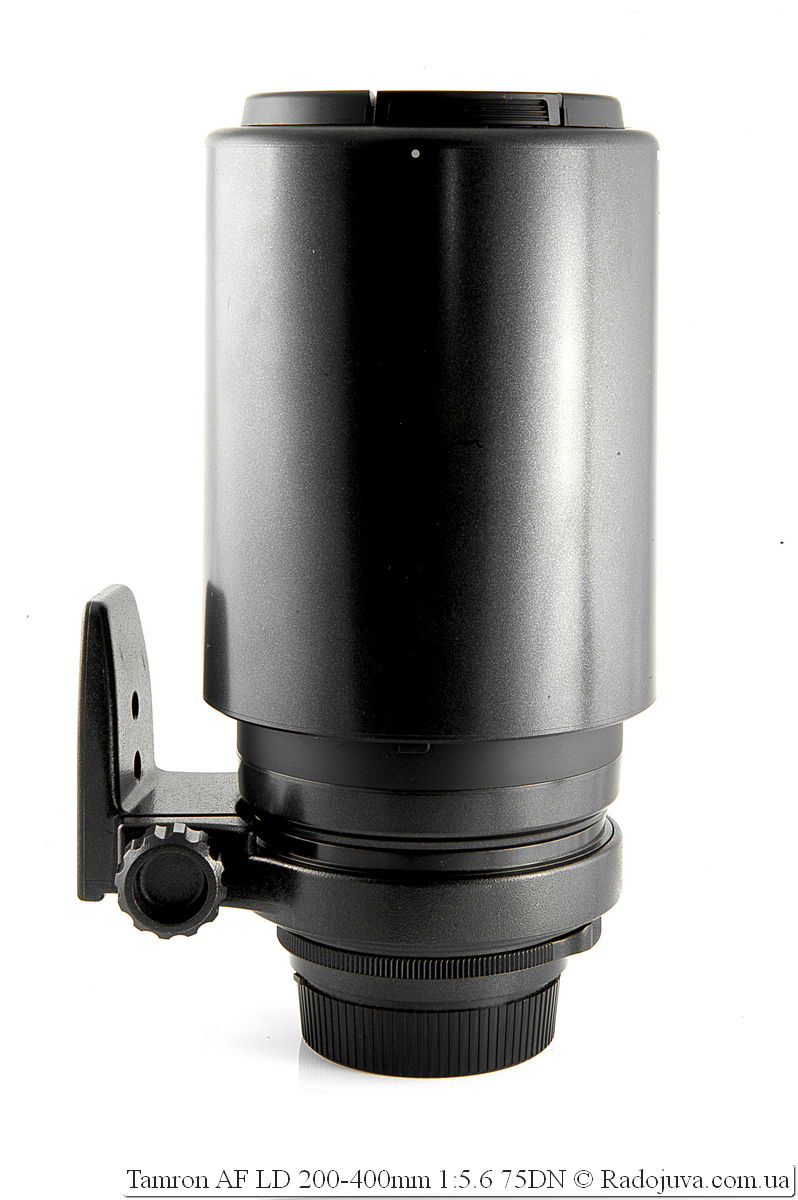
Tamron AF 200-400 F / 5.6 LD
Sample Photos
You lot can download RAW source files at this link (16 files in '.NEF' format, 216 MB). All photos were taken on Nikon D700.

Tamron AF 200-400 F / 5.vi LD
My experience
I 'played' with this lens for about two weeks. I often shoot with old trash, and therefore I am condescending to some optical jambs of erstwhile lenses and try to squeeze out the maximum quality from them. In the case of the Tamron AF 200-400 F / 5.half dozen LD, you can really clasp a lot out of information technology. I really liked the build quality and blurring of the near / far shots at open up apertures. Given its cost, you tin safely purchase the Tamron AF 200-400 F / v.half dozen LD for amateur photography and uncomplicated photography.
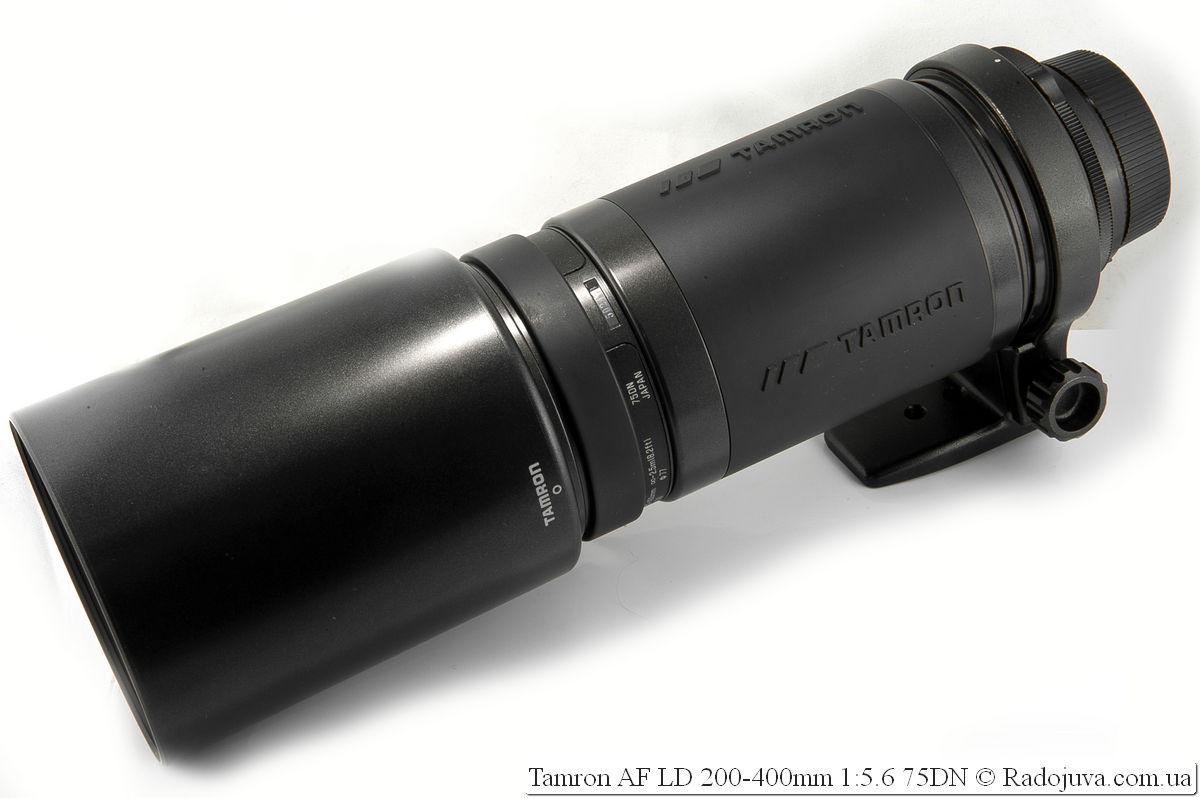
Tamron AF 200-400 F / 5.6 LD
Catalog of modern Tamron lenses can look at this link.
Comments on this post exercise not require registration. Anyone tin can get out a comment. A wide variety of photographic equipment can be found on AliExpress, Amazon и B&H Photo.
Results
The Tamron AF LD 200-400mm 1: five.six 75DN is a super budget auto focus super telephoto zoom lens. I am pleased with the excellent assembly and nice drawing, the weak sharpness and slow focusing disappoint. I would recommend, without a strong need for that, to stick with some honest 70-300 / 3.5-5.half-dozen, rather than get involved with this lens.
Cloth prepared Arkady Shapoval... Look for me on Youtube | Facebook | Instagram | Twitter.
desrosiersmartyart.blogspot.com
Source: https://radojuva.com/en/2015/12/tamron-af-ld-200-400-75-d-n/
0 Response to "Tamron Af 200-400mm F56 Ld 75dn for Nikon Review"
Post a Comment